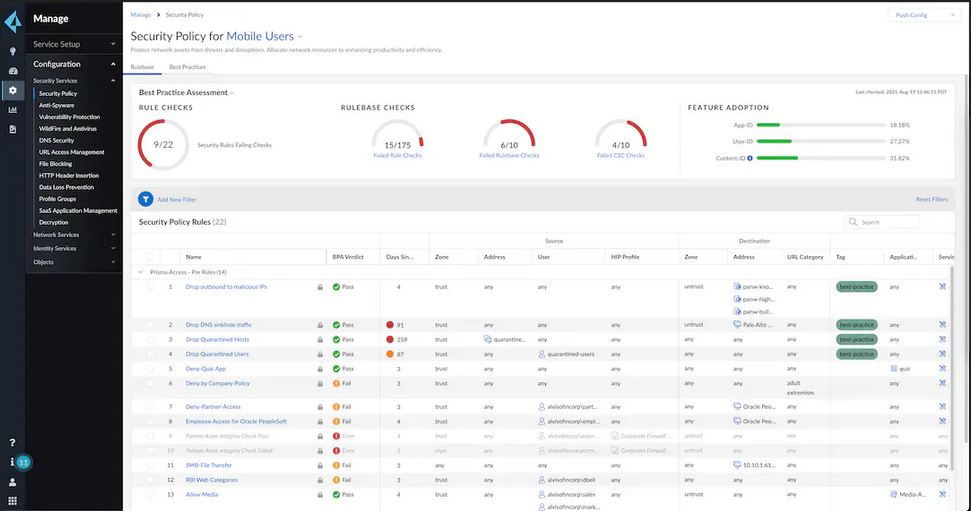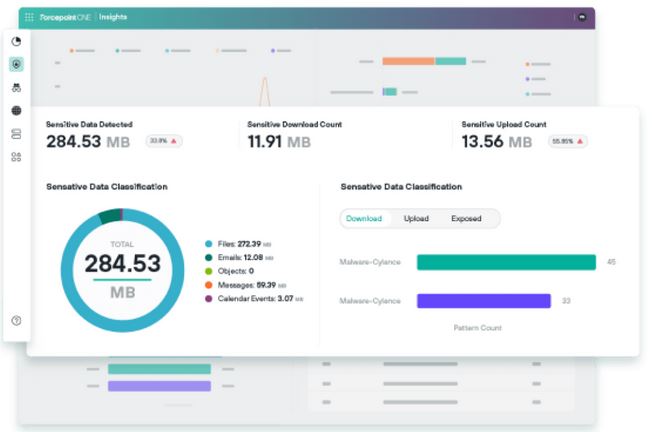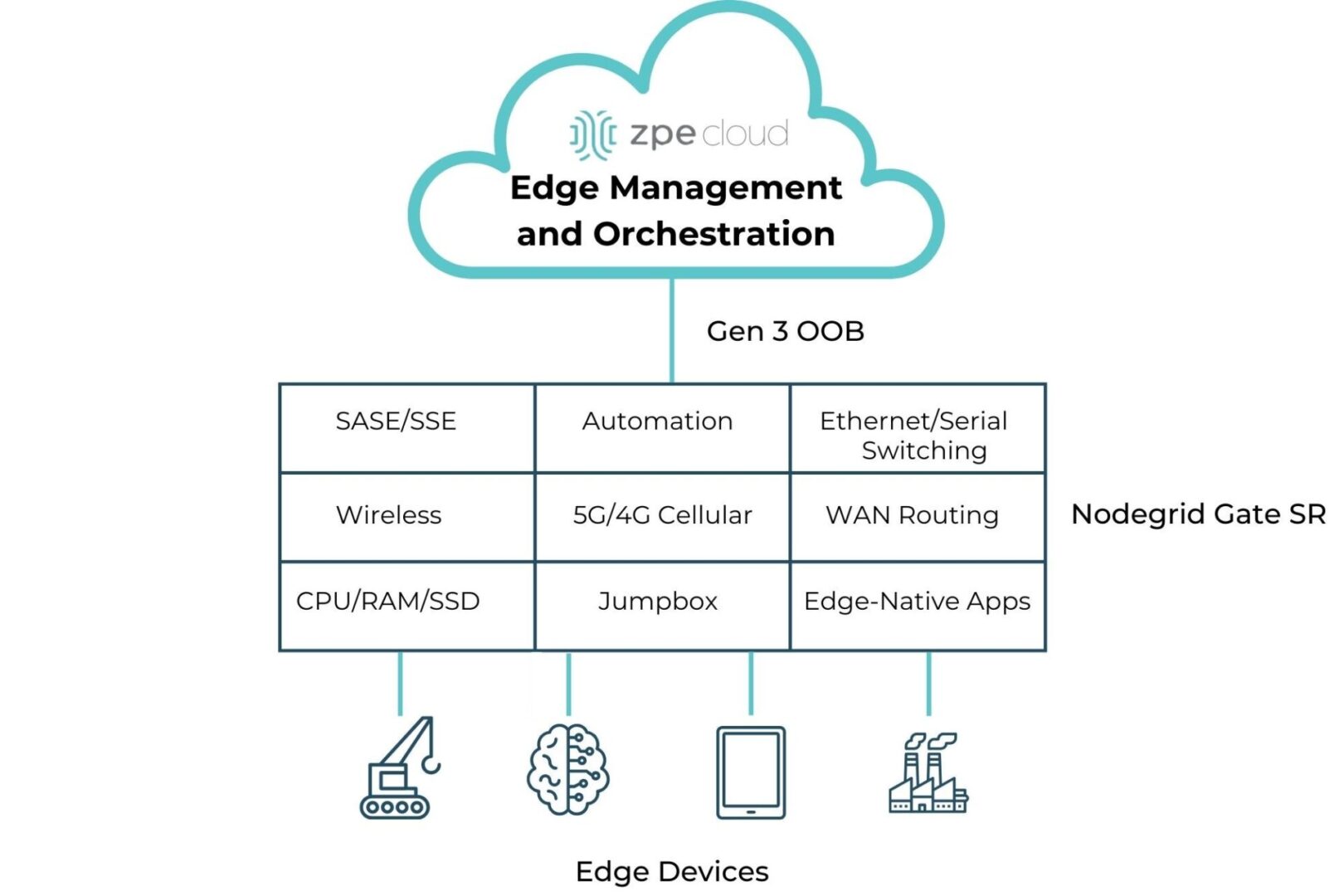
Edge security solutions decentralize the enterprise security stack, delivering key firewall capabilities to the network’s edges. This prevents companies from funneling all edge traffic through a centralized data center firewall, reducing latency and improving overall performance.
This guide compares the most popular edge security solutions and offers recommendations for choosing the right vendor for your use case.
Executive summary
There are six single-vendor SASE solutions offering the best combination of features and capabilities for their targeted use cases.
.
The best edge security solution for Gen 3 out-of-band (OOB) management, which is critical for infrastructure isolation, resilience, and operational efficiency, is Nodegrid from ZPE Systems. Nodegrid provides secure hardware and software to host other vendors’ tools on a secure, Gen 3 OOB network. It creates a control plane for edge infrastructure that’s completely isolated from breaches on the production network and consolidates an entire edge networking stack into a single solution. Disclaimer: This comparison was written by a third party in collaboration with ZPE Systems using publicly available information gathered from data sheets, admin guides, and customer reviews on sites like Gartner Peer Insights, as of 6/09/2024. Please email us if you have corrections or edits, or want to review additional attributes, at [email protected].
What are edge security solutions?
Edge security solutions primarily fall into one (or both) of two categories:
- Security Service Edge (SSE) solutions deliver core security features as a managed service. SSE does not come with any networking capabilities, so companies still need a way to securely route edge traffic through the (often cloud-based) security stack. This usually involves software-defined wide area networking (SD-WAN), which was traditionally a separate service that had to be integrated with the SSE stack.
- Secure Access Service Edge (SASE) solutions package SSE together with SD-WAN, preventing companies from needing to deploy and manage multiple vendor solutions.
All the top SSE providers now offer fully integrated SASE solutions with SD-WAN. SASE’s main tech stack is in the cloud, but organizations must install SD-WAN appliances at each branch or edge data center. SASE also typically uses software agents deployed at each site and, in some cases, on all edge devices. Some SASE vendors also sell physical appliances, while others only provide software licenses for virtualized SD-WAN solutions. A third category of edge security solutions offers a secure platform to run other vendors’ SD-WAN and SASE software. These solutions also provide an important edge security capability: management network isolation. This feature ensures that ransomware, viruses, and malicious actors can’t jump from compromised IoT devices to the management interfaces used to control vital edge infrastructure.
Comparing edge security solutions
Palo Alto Prisma SASE

Palo Alto Prisma SASE Capabilities:
- Zero Trust Network Access (ZTNA) 2.0 – Automated app discovery, fine-grained access controls, continuous trust verification, and deep security inspection.
- Cloud Secure Web Gateway (SWG) – Inline visibility and control of web and SaaS traffic.
- Next-Gen Cloud Access Security Broker (CASB) – Inline and API-based security controls and contextual policies.
- Remote Browser Isolation (RBI) – Creates a secure isolation channel between users and remote browsers to prevent web threats from executing on their devices.
- App acceleration – Application-aware routing to improve “first-mile” connection performance.
- Prisma Access Browser – Policy management for edge devices.
- Firewall as a Service (FWaaS) – Advanced threat protection, URL filtering, DNS security, and other next-generation firewall (NGFW) features.
- Prisma SD-WAN – Elastic networks, app-defined fabric, and Zero Trust security.
Zscaler Zero Trust SASE
Zscaler is another 2023 SSE Magic Quadrant Leader offering a robust single-vendor SASE solution based on its Zero Trust ExchangeTM platform. Zscaler SASE uses artificial intelligence to boost its SWG, firewall, and DEM capabilities. It also offers IoT device management and OT privileged access management, allowing companies to secure unmanaged devices and provide secure remote access to industrial automation systems and other operational technology. Zscaler offers fewer security features than some of the other vendors on the list, but its capabilities and future roadmap align well with the requirements of many enterprises, especially those with large IoT and operational technology deployments.
Zscaler Zero Trust SASE Capabilities:
- Zscaler Internet AccessTM (ZIA) – SWG cyberthreat protection and zero-trust access to SaaS apps and the web.
- Zscaler Private AccessTM (ZPA) – ZTNA connectivity to private apps and OT devices.
- Zscaler Digital ExperienceTM (ZDX) – DEM with Microsoft Copilot AI to streamline incident management.
- Zscaler Data Protection – CASB/DLP secures edge data across platforms.
- IoT device visibility – IoT device, server, and unmanaged user device discovery, monitoring, and management.
- Privileged OT access – Secure access management for third-party vendors and remote user connectivity to OT systems.
- Zero Trust SD-WAN – Works with the Zscaler Zero Trust Exchange platform to secure edge and branch traffic.
Netskope ONE

Netskope ONE Capabilities:
- Next-Gen SWG – Protection for cloud services, applications, websites, and data.
- CASB – Security for both managed and unmanaged cloud applications.
- ZTNA Next – ZTNA with integrated software-only endpoint SD-WAN.
- Netskope Cloud Firewall (NCF) – Outbound network traffic security across all ports and protocols.
- RBI – Isolation for uncategorized and risky websites.
- SkopeAI – AI-powered threat detection, UEBA, and DLP
- Public Cloud Security – Visibility, control, and compliance for multi-cloud environments.
- Advanced analytics – 360-degree risk analysis.
- Cloud Exchange – Multi-cloud integration tools.
- DLP – Sensitive data discovery, monitoring, and protection.
- Device intelligence – Zero trust device discovery, risk assessment, and management.
- Proactive DEM – End-to-end visibility and real-time insights.
- SaaS security posture management – Continuous monitoring and enforcement of SaaS security settings, policies, and best practices.
- Borderless SD-WAN – Zero trust connectivity for edge, branch, cloud, remote users, and IoT devices.
Cisco
Cisco is one of the only edge security vendors to offer SASE as a managed service for companies with lean IT operations and a lack of edge networking experience. Cisco Secure Connect SASE-as-a-service includes all the usual SSE capabilities, such as ZTNA, SWG, and CASB, as well as native Meraki SD-WAN integration and a generative AI assistant. Cisco also provides traditional SASE by combining Cisco Secure Access SSE – which includes the Cisco Umbrella Secure Internet Gateway (SIG) – with Catalyst SD-WAN. Cisco Secure Connect makes SASE more accessible to smaller, less experienced IT teams, though its high price tag could be prohibitive to these companies. Cisco’s unmanaged SASE solutions integrate easily with existing Cisco infrastructures, but they offer less flexibility in the choice of features than other options on this list.
Cisco Secure Connect SASE-as-a-Service Capabilities:
- Clientless ZTNA
- Client-based Cisco AnyConnect secure remote access
- SWG
- Cloud-delivered firewall
- DNS-layer security
- CASB
- DLP
- SAML user authentication
- Generative AI assistant
- Network interconnect intelligent routing
- Native Meraki SD-WAN integration
- Unified management
Cisco Secure Access SASE Capabilities
- ZTNA
- SWG
- CASB
- DLP
- FWaaS
- DNS-layer security
- Malware protection
- RBI
- Catalyst SD-WAN
Forcepoint ONE

Forcepoint ONE Capabilities:
- CASB – Access control and data security for over 800,000 cloud apps on managed and unmanaged devices.
- ZTNA – Secure remote access to private web apps.
- SWG – Includes RBI, content disarm & reconstruction (CDR), and a cloud firewall.
- Data Security – A cloud-native DLP to help enforce compliance across clouds, apps, emails, and endpoints.
- Insights – Real-time analysis of live telemetry data from Forcepoint ONE security products.
- FlexEdge SD-WAN – Secure access for branches and remote edge sites.
Fortinet FortiSASE
Fortinet’s FortiSASE platform combines feature-rich, AI-powered NGFW security functionality with SSE, digital experience monitoring, and a secure SD-WAN solution. Fortinet’s SASE offering includes the FortiGate NGFW delivered as a service, providing access to FortiGuard AI-powered security services like antivirus, application control, OT security, and anti-botnet protection. FortiSASE also integrates with the FortiMonitor DEM SaaS platform to help organizations optimize endpoint application performance. FortiSASE provides comprehensive edge security functionality for large enterprises hoping to consolidate their security operations with a single platform. However, the speed of some dashboards and features – particularly those associated with the FortiMonitor DEM software – could be improved for a better administrative experience.
Fortinet FortiSASE Capabilities:
- Antivirus – Protection from the latest polymorphic attacks, ransomware, viruses, and other threats.
- DLP – Prevention of intentional and accidental data leaks.
- AntiSpam – Multi-layered spam email filtering.
- Application Control – Policy creation and management for enterprise and cloud-based applications.
- Attack Surface Security – Security Fabric infrastructure assessments based on major security and compliance frameworks.
- CASB – Inline and API-based cloud application security.
- DNS Security – DNS traffic visibility and filtering.
- IPS – Deep packet inspection (DPI) and SSL inspection of network traffic.
- OT Security – IPS for OT systems including ICS and SCADA protocols.
- AI-Based Inline Malware Prevention – Real-time protection against zero-day exploits and sophisticated, novel threats.
- URL Filtering – AI-powered behavior analysis and correlation to block malicious URLs.
- Anti-Botnet and C2 – Prevention of unauthorized communication attempts from compromised remote servers.
- FortiMonitor DEM – SaaS-based digital experience monitoring.
- Secure SD-WAN – On-premises and cloud-based SD-WAN integrated into the same OS as the SSE security solutions.
Edge isolation and security with ZPE Nodegrid
The Nodegrid platform from ZPE Systems is a different type of edge security solution, providing secure hardware and software to host other vendors’ tools on a secure, Gen 3 out-of-band (OOB) management network. Nodegrid integrated branch services routers use alternative network interfaces (including 5G/4G LTE) and serial console technology to create a control plane for edge infrastructure that’s completely isolated from breaches on the production network. It uses hardware security features like secure boot and geofencing to prevent physical tampering, and it supports strong authentication methods and SAML integrations to protect the management network. 
ZPE Nodegrid Edge Security Capabilities
- Vendor-neutral platform – Hosting for third-party applications and services, including Docker containers and virtualized network functions.
- Gen 3 OOB – Management interface isolation and 24/7 remote access during outages and breaches.
- Branch networking – Routing and switching, VNFs, and software-defined branch networking (SD-Branch).
- Secure boot – Password-protected BIO/Grub and signed software.
- Latest kernel & cryptographic modules – 64-bit OS with current encryption and frequent security patches.
- SSO with SAML, 2FA, & remote authentication – Support for Duo, Okta, Ping, and ADFS.
- Geofencing – GPS tracking with perimeter crossing detection.
- Fine-grain authorization – Role-based access control.
- Firewall – Native IPSec & Fail2Ban intrusion prevention and third-party extensibility.
- Tampering protection – Configuration checksum and change detection with a configuration ‘reset’ button.
- TPM encrypted storage – Software encryption for SSD hardware storage.
Deploy edge security solutions on the vendor-neutral Nodegrid OOB platform
Nodegrid’s secure hardware and vendor-neutral OS make it the perfect platform for hosting other vendors’ SSE, SD-WAN, and SASE solutions. Reach out today to schedule a free demo.
